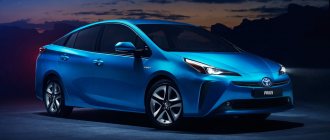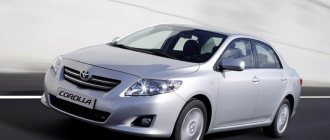Average fuel consumption on a Toyota RAV 4 is an indirect criterion for determining the serviceability of the main components of the car. The parameter depends on the displacement, transmission type, operating conditions, load level and fuel quality. With a sharp increase in costs, the owner needs to diagnose the machine and eliminate faults.
Fuel consumption is an important criterion for choosing a car.
Characteristics of Toyota RAV 4 engines
Toyota RAV4 compact crossovers were equipped with liquid-cooled in-line engines located transversely. The cars used gasoline units with fuel injection and emission reduction systems. Since 2005, a model with a 6-cylinder V-engine producing 269 hp has been assembled in small batches for the American market. With. (volume 3.5 l). All power units were developed by Toyota (no third-party products were used).
On diesel
On RAV 4 cars there are power units with compression ignition:
- On generation II cars, a 2-liter D-4D series engine with a power of 116 hp was used. pp., equipped with a supercharging system without an intermediate radiator. The unit worked in conjunction with a manual gearbox, which distributed torque between all wheels.
- On the XA30 generation, a power unit with a supercharging system and an intermediate radiator began to be used, developing 136 or 177 hp. With. The all-wheel drive system and manual transmission were retained; average consumption ranged from 6.6 to 7.2 liters.
- After the start of production of the CA40 generation, the engine received a soot particle collection system, which reduced exhaust toxicity. The turbine with a boost pressure regulator was preserved; the power was 150 hp. With.
On gasoline
... about the model parameters
Gasoline engines with a 4-valve gas distribution system were equipped with a VVTi phase adjustment system, which increased torque and improved efficiency. The electronically controlled ignition system automatically adjusted the timing.
Gasoline engines improve efficiency.
Gasoline was supplied to the intake manifold cavity by fuel injectors, and the exhaust system had a catalytic converter with feedback.
Restyling generation 2 (XA20, 2003-2005)
The engine range has not changed, and has been replenished with a 2.4, 167 liter engine. pp., transmission options - automatic and manual. A car with such an internal combustion engine was offered only with all-wheel drive.
Generation 3 (XA30, 2006 – 2010)
- 2.0, 152 l. p., manual, full, 10.6 sec to 100 km/h, 11/7.4 l per 100 km
- 2.0, 152 l. s., automatic, full, 12 sec to 100 km/h, 11/7.2 l per 100 km
Restyling generation 3 (XA30, 2010-2013)
- 2.0, 158 l. p., CVT, full, 11 sec to 100 km/h, 9.5/6.4 l per 100 km
- 2.0, 158 l. s., manual, full, 10.5 sec to 100 km/h, 9.6/6.4 l per 100 km
- 2.0, 158 l. p., manual, front, 10.2 sec to 100 km/h, 9.4/6.2 l per 100 km
Generation 4 (CA40, 2013 – 2015)
- 2.0, 145 l. p., manual, front, 10.2 sec to 100 km/h, 10/6.4 l per 100 km
- 2.0, 145 l. p., manual, full, 10.7 sec to 100 km/h, 10.6.4 l per 100 km
- 2.0, 145 l. p., CVT, full, 11.3 sec to 100 km/h, 9.4/6.3 l per 100 km
- 2.0, 145 l. sec., CVT, front, 11.1 sec to 100 km/h, 9.4/6.3 l per 100 km
- 2.5, 179 l. s., automatic, full, 9.4 sec to 100 km/h, 11.4/6.8 l per 100 km
2.2, 149 l. p.s., automatic, full, 10 sec to 100 km/h, 8.2/5.5 l per 100 km
Restyling generation 4 (CA40, 2015 – present)
- 2.0, 146 l. p., manual, front, 10.2 sec to 100 km/h, 9.7/6.4 l per 100 km
- 2.0, 146 l. sec., CVT, front, 11.1 sec to 100 km/h, 9.4/6.3 l per 100 km
- 2.0, 146 l. p., CVT, full, 11.3 sec to 100 km/h, 9.4/6.4 l per 100 km
- 2.5, 180 l. p.s., automatic, full, 9.4 sec to 100 km/h, 11.6/6.9 l per 100 km
Source
Official fuel consumption for Toyota RAV 4
The cars were supplied to various markets; the power and efficiency of the engine depended on local environmental standards. For example, in the USA there were increased requirements for exhaust toxicity, which forced the manufacturer to install improved neutralizers. Official data is determined during certification tests at the test site. By creating special conditions (no slopes, good tire adhesion to the road), the manufacturer manages to achieve consumption unattainable during standard operation.
2.0 AT MT
Efficiency of cars with 2-liter units:
- On the XA10 generation, gasoline consumption (octane number not lower than 92) when using a manual transmission is 9.8 and 10.7 liters for front-wheel drive and all-wheel drive, respectively. For models with automatic transmission, the parameters are set at 10.2 and 10.7 liters. The economy of the car does not depend on the number of doors (models with 3 or 5 doors were available, as well as a modification with a partially soft top).
- On the XA20 generation, when using a manual gearbox, consumption was stated at levels from 9.4 to 10.7 liters (depending on the drive), the automatic gearbox allowed it to be 9.8 and 10.2 liters per 100 km, respectively.
- On the XA30 and CA40 models (158 and 151 hp, respectively), the plant declared consumption in combined mode at the level of 7.2-7.6 liters.
Diesel RAV-4 2.2 MT AT
Fuel consumption when using a diesel engine of the D-4D series in the average cycle is 7.1 liters per 100 kilometers. After upgrading and increasing power, efficiency improved; in combined mode, the unit required from 6.0 to 7.2 liters, and on the highway the crossover required 5.5 liters of diesel fuel per “hundred”. With the start of production of the IV generation of cars, the engine was modernized, with a power of 124 hp. With. and a manual transmission with front-wheel drive in mixed mode, the unit burned only 4.9 liters.
The fuel consumption of the diesel 2.2 MT AT is 7.1 liters per 100 kilometers.
Toyota RAV-4 2.4 AT
The 161-horsepower 2.4-liter engine used in the XA20 generation burned, according to factory measurements, 9.8 liters of fuel when using an automatic transmission and front-wheel drive. The version with all drive wheels was distinguished by increased fuel consumption, reaching 10.7 liters. When installing a manual transmission with drive on the front axle, the parameter was 9.8 liters, but when using all-wheel drive, the average consumption reached 11.2 liters per “hundred”.
After the start of production of the XA30 generation, customers were offered a 166-horsepower version that consumed from 9.8 to 10.2 liters of fuel (4x2 and 4x4 transmissions, respectively). The power unit was only available with a 4-speed automatic transmission. After the modernization carried out in 2008, a 2.5 liter engine began to be used, which had improved characteristics. Efficiency decreased, the installation required from 10.7 to 11.2 liters of gasoline with an octane rating of 95 (short-term use of the A-92 grade was allowed).
Owner's advice: what kind of gasoline is better to fill in the Rav4
Fuel consumption on kia rio x (x-line) in detail about fuel consumption
Taking into account the recommendations of official manufacturers on the type and properties of gasoline required for the Rav4, you need to pay attention to the operating conditions of the car, as well as the quality of the fuel being poured. Over more than 30 years of production of the Toyota Rav4, owners have developed conflicting opinions about the choice of fuel
Reviews on popular forums about the quality of domestic gasoline coexist with disputes about the correctness of the manufacturer’s regulatory requirements for fuel. Experienced Rav4 owners advise refueling with 95-octane gasoline at gas stations of proven and well-known brands, since this is the only way to be sure of the purity and quality of the fuel, which will not harm the car.
Real fuel consumption for Toyota RAV4 per 100 km
The results obtained during the operation of the machines differ significantly from the figures declared by the plant. The reasons for the difference are: natural wear and tear of the main components of the equipment, the use of fuel of reduced quality, careless handling of the accelerator pedal or overload. The diagnostic system checks the condition of control units and ignition system components; if a malfunction is detected in the instrument cluster, the Check Engine lamp turns on. To determine the faulty unit, a scanner is used that reads and decrypts error codes.
Generation 1 XA10
The first generation cars used a 2-liter 3S-FE engine, working with a 4-speed automatic or 5-speed manual gearbox. When driving on the highway at a calm pace, cars on standard tires consume from 8.5 to 9 liters of gasoline, in the city the parameter reaches 14-16 liters per 100 km. Expedition options with special tires and attachments burn 10-20% more fuel.
Generation 1 XA10 use a 2-liter 3S-FE engine.
Generation 2 XA20
After the start of production of the XA20 generation, a 1.8-liter 125-horsepower gasoline engine appeared under the hood of the RAV 4. On the highway, the car burns 7-8 liters (at an average speed of up to 90 km/h and avoiding sudden acceleration), in the city the car burns from 11 liters. The production program included a RAV 4 with a 2-liter engine producing 150 hp. pp., consuming from 8 to 16 liters of A-92 gasoline (on the highway and in city traffic).
Restyling of the second generation Toyota RAV-4
During the modernization, the manufacturer retained the old modifications of the power units, the efficiency of the engines remained unchanged. A 2.4-liter version (power 161 hp) appeared in the line of available gasoline engines, offered with a 4-speed automatic transmission (cars with manual transmission were sold in a number of markets). Due to the all-wheel drive system and increased working volume, consumption in the city reaches 17-18 liters, which forces owners to switch their cars to gas. In highway operation, the engine burns up to 9 liters per 100 km.
Restyling of the second generation retained the old modifications.
Generation 3 XA30 and restyling
Owners of XA30 cars with a base 2.4-liter engine are faced with high gasoline consumption in urban conditions, reaching 14 liters or more. The modification with a V-shaped power unit has good dynamics (at the level of passenger cars), but during sharp acceleration the engine burns up to 20 liters per “hundred”. During highway use (speed up to 100 km/h and partially loaded interior), crossovers fit into 8-9 liters.
Turning on the air conditioner does not affect the dynamics; gasoline costs increase by 0.3-0.4 liters.
Generation 4 CA40 and re-release
In 2012, the production of a new generation CA40 with gasoline engines of 2 and 2.5 liters began. According to owner reviews, the average consumption on a country road ranges from 7 to 9 liters (the most economical version is the version with a continuously variable CVT). In populated areas with heavy traffic, engines require from 9 to 11 liters; in winter, for short trips, the parameter increases by 1-2 liters.
Generation 4 CA40 is available with 2 and 2.5 liter petrol engines.
Crossovers for the 2021 model year that have undergone modernization have similar fuel economy. On the IV generation there is a 2.2-liter 150-horsepower diesel engine, working with an automatic transmission and all-wheel drive system. On the highway you can fit in 5.5-6 liters of fuel; in an average cycle, the power unit burns 7-7.5 liters of fuel.
At air temperatures below -15°C, the parameter increases by 1-1.5 liters (due to the need to warm up the car interior).
Interior
How much fuel does Renault Duster consume?
The crossover has finally received an updated instrument panel. Now, instead of the outdated optitron, a 4.2-inch color display is installed. Engine speed and revolutions are based on classic dial indicators with soft backlighting.
The steering wheel is now heated. The multimedia system control keys have been revised and installed in a new order; in the dark they are still illuminated by LEDs. The steering wheel has received a new braid made of fine genuine leather. Each line is adjusted with jewelry precision.
The materials of the torpedo have improved noticeably. The plastic at the top is soft and pleasant to the touch. A genuine leather insert has been added in the area of the climate control system. The multimedia system is located in a convenient location; trapezoidal-shaped air ducts are installed on the sides. But the Japanese engineers made a mistake with the seat heating control unit - reaching for it is inconvenient and you have to take your attention from the road.
The gearshift lever is made in a classic style with a pleasant position illumination. All interior parts look good, the gaps and fit are excellent.
The driver and passenger seats have become even more comfortable. By the way, heating is now installed in the back row. The anatomical shape of the backrest will not allow passengers to get tired even during a long journey, and the expanded adjustment system will help you choose a comfortable position.
What affects the fuel consumption of Toyota Rav 4
The fuel efficiency of the RAV 4 is affected by:
- aerodynamic drag;
- low tire pressure;
- road conditions;
- cabin load;
- condition of power supply and exhaust gas systems;
- quality of engine and transmission oils;
- condition of the air filter cartridge;
- car driving style.
Modification 2.5 AT (since 2013)
In 2013, the global community of car enthusiasts had the opportunity to see the presentation of the Toyota RAV 4 with a 2.5-liter engine. The model was based on the Long version from the previous generation. This engine became the most powerful version available for the European buyer - 180 horsepower. The manufacturer has assured the following gasoline consumption standards: 11.5 liters per hundred in the city, 7 liters on the highway.
Owners of Toyota Rav 4 2.5 leave the following reviews regarding the actual gasoline consumption of this modification:
- Albert, Orel. I have a new car, purchased it in 2016. I couldn't be happier with the new version. The car got even bigger. It's good for the whole family to go on vacation. So far it takes about 14 liters per hundred, but I’m sure this is the first time. I fill in high-quality gasoline, so soon the mark will creep down.
- Ivan, Cheboksary. As soon as I found out about the release of the new version of Toyota Rav 4, I immediately decided to raise the necessary amount. In 2021, I purchased a car that was already 2 years old and under 100 thousand km. No problems. I am sure that there will not be up to 300 thousand of them. The Japanese produce extremely reliable SUVs. So, only if you have to change something for little things in the worst case scenario. Today my on-board computer shows 12 liters in the city in the summer and 13 liters in the winter.
- Nikolay, Tver. Yes, the new engine is incredibly powerful. I've driven Japanese cars all my life, and I've only spent the last two years driving an SUV. The impressions are indescribable. Of course it's a big expense for me. But while I can, I pay for the pleasure. Because you simply don’t want to get up from behind the wheel of the Rav 4. All-wheel drive with automatic transmission does the job. I travel around Tver with great pleasure all day long. It consumes about 13 liters per 100 km with quiet driving.
- Yuri, Khabarovsk. I bought the “comfort” package for more than 2 million rubles. All inclusive. All at the highest level. I didn’t notice the difference in gasoline consumption between my car and my neighbor’s 2.0-liter engine. What I have, what he has 12.5 in the city. On the track I have 9 liters, he has 8. The difference is insignificant, but I have as many as 180 horses under the hood. The difference is obvious.
Buying a car is a serious matter
When choosing a model, you need to think about everything, pay attention not only to the appearance of the body, but also to the technical characteristics, especially how much fuel is consumed when driving. In this article we will draw your attention to the fuel consumption of Toyota Rav 4
How to reduce fuel consumption
To reduce fuel costs in a working car, you should maintain an average speed on the highway within 90-100 km/h, focusing on the instantaneous consumption readings in the on-board computer. It is necessary to minimize sudden accelerations and prolonged idling (for example, when sitting in traffic jams or while waiting for passengers). Overloading or operating with a trailer has a negative impact on efficiency; installing a luggage carrier on the roof or driving on tires with low pressure increases fuel consumption by 10-15%.
Engine 2.2 MT+AT DIESEL
The 2.2 diesel engine pleases car enthusiasts with efficiency and power. This modification shows the lowest possible consumption (both automatic and manual).
Modifications and characteristics of Toyota RAV4 2.2d:
- XA40 (2013-2015) – 150 hp, front-wheel drive, automatic transmission. Consumption in the urban cycle – 8.1 l/100 km; suburban – 5.9; mixed – 6.7.
- 4WD (2010) – 150 hp, permanent all-wheel drive. Fuel consumption with MT – 7.5 / 5.2 / 6.0 (city / highway / mixed). With AT – 8.8 / 6.2 / 7.2.
- D 4WD (2010-2012) – 177 hp, permanent all-wheel drive, manual transmission. Diesel consumption – 5.9 / 7.9 / 6.7.
- D-CAT 4WD (2009) – 177 hp, permanent drive, MT. The car consumes 7.9 / 5.9 / 6.7 l/100 km.
Car owners note that the average diesel fuel consumption in the rough in the city is actually 8.5-9.7 l/100 km.
Engine models for Rav4
Over the course of a quarter of a century, different engines have been installed on the Rav4. The most common engine is the 1AZ-FE, which was installed from 2000 until 2010, as well as the 3ZR-FE, which replaced the previous generation of engines and is invariably installed on all cars up to the new generation of Toyota Rav4, released in 2021 . The working volume of both power plants was 2 liters, and the power according to the passport was around 150 horsepower. They were also related by the choice of combination with front-wheel drive or all-wheel drive, manual, automatic or CVT transmission. Both engines are gasoline, naturally aspirated.
More powerful engines were also offered. Since 2012, a 180-horsepower 2.5-liter engine has become available to the buyer; in the latest generation, the power has been increased to a record 199 horsepower for the Rav4. This power plant is only available in the maximum configuration.
Japanese version
For the markets of Japan and Australia, a modification with right-hand drive was offered; bodies with 3 and 5 doors were available. In addition to gasoline, there was a model with a diesel engine of the D-4D generation, equipped with turbocharging.
The cars differed in a number of options (for example, navigation with a color screen was offered) and were equipped with an additional mirror on the front left wing. Japanese cars often had a sunroof, and a 1-zone climate control system was installed.
Modification 2.0 AT+MT (I-IV generation)
The two-liter engine was installed on all four generations of Rav 4. This engine is paired with both an automatic and a manual gearbox, as for the gasoline counterpart. The 2-liter diesel engine began to be installed starting from the second generation. It only works in conjunction with mechanics. The modernization of the 2.0 power unit took place in the following stages:
- The first generation was equipped with a motor with a declared power of 128 horsepower. Consumption rates: 12.5 l in the city, 7.7 l on the highway;
- On second-generation cars you can find a modernized 2.0-liter gasoline engine with a capacity of 150 horses and a diesel engine with 116 horsepower. Consumption of the gasoline analogue: 11.5 l – city, 7.5 l – highway;
- The third generation acquired a completely new two-liter engine with two levels - 152 and 158 horsepower. The fuel consumption rate remained unchanged. As a transmission, it became possible to install a continuously variable variator;
- The fourth generation was equipped with the engine from the third generation. Consumption actually remained the same, but the manufacturer assured a reduction in fuel consumption by 2%.
Owners of a Toyota Rav 4 with a 2-liter engine leave the following data regarding the fuel consumption of the car:
- Alexander, Kemerovo. I have a 2000 Rav 4. I want to say that the car is made to last. There will be a lot more driving. If you drive along the highway at a speed of 100 km/h, you can achieve maximum savings of 8 liters per hundred. I am completely satisfied with the car, good cross-country ability. Yes, the design is a little outdated, but I’m not chasing fashion. For me, the main thing is quality and gasoline consumption in the city is around 11-12 liters.
- Vasily, Ulyanovsk. I've been driving a 2005 Toyota Rav 4 for more than three years. I bought the car on the secondary market. A worthy offer was found; the previous owner drove it very little. What I want to say about the “appetite” of the car: I recorded the maximum figure in winter - 13 liters. If we take it in general, then on average in summer AI-92 consumes around 12 liters. On the highway approximately 8.5 liters.
- Maxim, Ryazan. I have been the owner of the “rafchik” since 2008. If you believe the on-board computer indicators, then my car burns 11 liters per hundred in the city, both in winter and summer. Car with manual transmission. A friend of mine also has a third generation Rav 4, but it has an automatic. The numbers reach 13-14 liters in winter. I suspect it depends on driving style.
- Eduard, Moscow. I have a 2012 car with a Multi-Drive CVT. At the very beginning, it took a lot of gasoline. Approximately 14 liters in the city. True, taking into account traffic jams and downtime. But after the break-in stage was completed, the numbers dropped to an acceptable 11-12 liters. As I understand it, there is no difference in numbers between the third and fourth generations? Here you also need to take into account the number of potholes on the road. The more there are, the worse it is for your pocket.
Car appearance
The cars were supplied with a long and short wheelbase; the design of the front and rear was unified. Massive bumpers made of thick plastic withstood impacts on obstacles at speeds of up to 10 km/h.
Some cars had protective sills made of steel pipes with rubber pads. Depending on the sales market, there were minor finishing nuances (for example, some cars did not have a decorative spare wheel cover installed).
Jeep/SUV 3-door
The shortened version had widened passenger doors; to access the rear row of seats, it was necessary to recline the backs of the front seats. The rear side windows smoothly transitioned into the glazing of the hinged trunk lid.
Short overhangs and 16-inch alloy wheels created a sporty look, although the crossover did not have high dynamic performance. On the side of the doors and along the perimeter of the wheel arches there were plastic protective linings painted in body color.
SUV 3-door with 16-inch alloy wheels.
Jeep/SUV 5 door
The modification with 5 doors was distinguished by increased capacity; there was a massive pillar between the glazing on the side of the body and the tailgate. The silhouette of the crossover has become imposing and conducive to a calm driving style.
The front lighting equipment with plastic lenses extends onto the edge of the wing, improving cornering lighting. On the trunk door there was a spare wheel and bulges traditional for the XA20 generation, which were a harmonious continuation of the vertical combination lamps.
Modification 2.5 AT (since 2013)
In 2013, the global community of car enthusiasts had the opportunity to see the presentation of the Toyota RAV 4 with a 2.5-liter engine. The model was based on the Long version from the previous generation. This engine became the most powerful version available for the European buyer - 180 horsepower. The manufacturer has assured the following gasoline consumption standards: 11.5 liters per hundred in the city, 7 liters on the highway.
Owners of Toyota Rav 4 2.5 leave the following reviews regarding the actual gasoline consumption of this modification:
- Albert, Orel. I have a new car, purchased it in 2016. I couldn't be happier with the new version. The car got even bigger. It's good for the whole family to go on vacation. So far it takes about 14 liters per hundred, but I’m sure this is the first time. I fill in high-quality gasoline, so soon the mark will creep down.
- Ivan, Cheboksary. As soon as I found out about the release of the new version of Toyota Rav 4, I immediately decided to raise the necessary amount. In 2015, I purchased a car that was already 2 years old and under 100 thousand kilometers. No problems. I am sure that there will not be up to 300 thousand of them. The Japanese produce extremely reliable SUVs. So, only if you have to change something for little things in the worst case scenario. Today my on-board computer shows 12 liters in the city in the summer and 13 liters in the winter.
- Nikolay, Tver. Yes, the new engine is incredibly powerful. I've driven Japanese cars all my life, and I've only spent the last two years driving an SUV. The impressions are indescribable. Of course it's a big expense for me. But while I can, I pay for the pleasure. Because you simply don’t want to get up from behind the wheel of the Rav 4. All-wheel drive with automatic transmission does the job. I travel around Tver with great pleasure all day long. It consumes about 13 liters per 100 km with quiet driving.
- Yuri, Khabarovsk. I bought the “comfort” package for more than 2 million rubles. All inclusive. All at the highest level. I didn’t notice the difference in gasoline consumption between my car and my neighbor’s 2.0-liter engine. What I have, what he has 12.5 in the city. On the track I have 9 liters, he has 8. The difference is insignificant, but I have as many as 180 horses under the hood. The difference is obvious.











